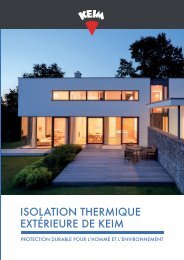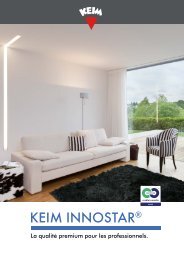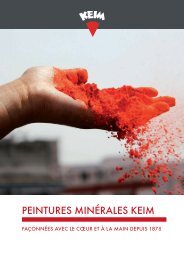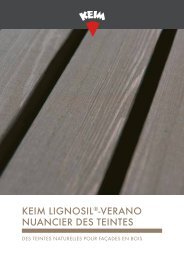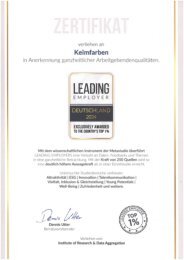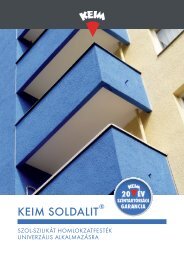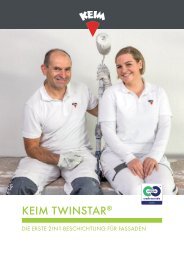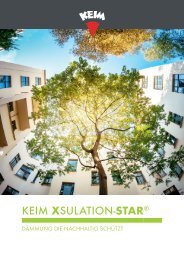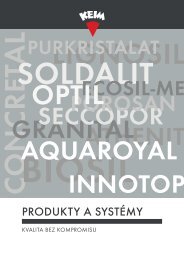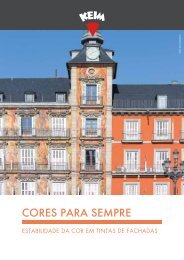KEIM Edition No. 2: Schmuttertal Grammar School
You also want an ePaper? Increase the reach of your titles
YUMPU automatically turns print PDFs into web optimized ePapers that Google loves.
CLIMATE, ECOLOGY, ENERGY<br />
Heating is scarcely needed at all, because 20 to 30 pupils in each classroom generate enough<br />
heat to maintain a pleasant temperature in a well-insulated room. A pellet boiler fired with renewable<br />
raw materials covers the remaining low energy demand. An underfloor heating system distributes<br />
the heat, which is only needed on particularly cold winter days.<br />
In summer on the other hand, the building has to be kept cool. The rooms therefore mainly point<br />
to the north or south so that they aren’t heated up unnecessarily by the low-lying sun in the east<br />
and west. South-facing windows are fitted with venetian blinds whose slats keep the sun out when<br />
it is standing high while still letting enough indirect daylight into the rooms to manage without<br />
artificial lighting. These passive measures already bring about a considerable reduction in the<br />
cooling requirements. If more is needed, the underfloor heating is changed over to an active<br />
cooling system: cold water flows through the pipes during the night and extracts heat from the<br />
room. The 10 cm cement screed acts as an accumulator that preserves the coolness of the night<br />
for the next day.<br />
Electricity is generated by a photovoltaic array on the roof. The annual energy yield exceeds the<br />
total primary energy needed for heating, cooling, ventilating and lighting the building. <strong>Schmuttertal</strong><br />
<strong>Grammar</strong> <strong>School</strong> therefore complies with the energy-plus standards, far surpassing most other<br />
school buildings.<br />
But the question is, will this annual energy surplus actually suffice to balance out the embodied<br />
energy that flowed into the actual construction of the building. After all, on the bottom line it is a<br />
case of how much harmful CO 2<br />
is saved throughout the entire life cycle of the building. The ecological<br />
footprint was based on a service life of 50 years. During this period, the building manages<br />
almost completely to “recover” the quantity of CO 2<br />
emitted during its construction, giving<br />
the school a carbon footprint of nearly zero.<br />
The carbon footprint of any building has to consider the climate impact of both the construction<br />
phase and the building’s subsequent use. A major role in the case of <strong>Schmuttertal</strong> <strong>Grammar</strong><br />
<strong>School</strong> is played by the very low impact that the wooden construction has on the climate, as<br />
seen in comparison with a conventional solid construction built according to the EnEV standard<br />
(German Energy-Saving Ordinance). Taken over a period of 50 years, the school in Diedorf<br />
managed to reduce the CO2 equivalent for construction and usage by around 95 percent.<br />
Climate potential 50 a in kg CO 2<br />
-equivalence<br />
Building operation<br />
Building construction<br />
60.000.000<br />
50.000.000<br />
40.000.000<br />
30.000.000<br />
20.000.000<br />
10.000.000<br />
0<br />
– 10.000.000<br />
Solid Construction<br />
in EnEV standard<br />
Timber<br />
construction as<br />
passive house<br />
<strong>Schmuttertal</strong><br />
<strong>Grammar</strong> <strong>School</strong><br />
25




